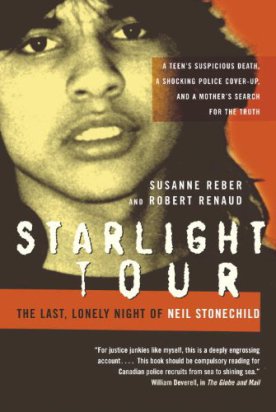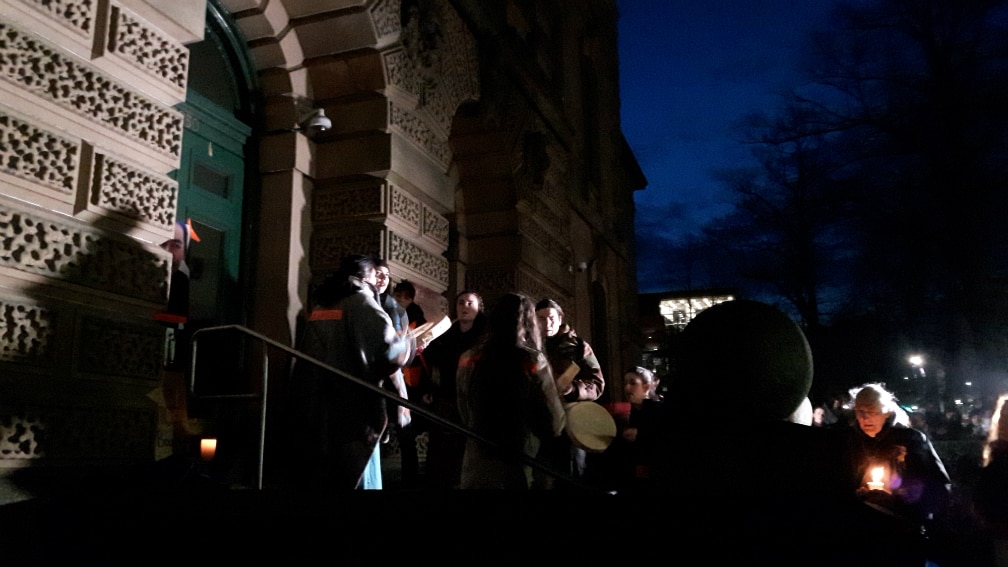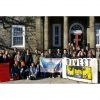KJIPUKTUK (Halifax) – Item: In winter 1990, 17-year-old Neil Stonechild, who was Indigenous, was found frozen to death in an industrial zone near Saskatoon. He was wearing a jean jacket, and only one shoe. Everyone recognized that he had been the victim of a ‘Starlight Tour’ – code for the police picking up Indigenous youth from the city streets, driving them to the edge of town and telling them to walk home.

The police picked up young Indigenous men for the crime of ‘walking while Indian’ or being intoxicated while on foot — plunking them, often in handcuffs, in the back of the police cruiser. The cops usually took away the youths’ coats and shoes before dumping them on the edge of town. After a significant public outcry, two cops were fired, but no one faced criminal charges in Stonechild’s murder. Everyone knew the outcomes of many “starlight tours.”2006 book
In fact, the “tours” were first detailed in a 1997 issue of a free advertising flyer called the Saskatoon Sun. In it, a Saskatoon police officer wrote a column called the Blue Lagoon.
His article “Beligerent [sic] drunk gets ride to highest power in land,” described two city cops who deliberately drove a “drunk” Aboriginal man to the city’s Queen Elizabeth power plant, miles from downtown late one night. Once at the remote location, one cop opened the back door of the cruiser and ordered the man out. The cop called out after him “one less guest for breakfast.”
In 2000, another Aboriginal man, Lawrence Wegner, was found frozen in a field near the Saskatoon dump. He was wearing only a t-shirt, socks and jeans, though it was the dead of winter. The RCMP refused to interview two witnesses who said they saw two policemen push Wegner into a police car early that evening. The police conducted no photo lineups, no lie detector tests and no further investigation. The police insisted they never picked Wegner up. The police theory was that the victim simply took a long walk on a sub-zero night; yet his socks showed no dirt or holes. No one was charged in Wegner’s death. Since 2000, at least 5 Indigenous men were found frozen to death just outside Saskatoon.
Are we going backwards? From 1990 into the 2000s there were no charges and no trials held in connection with the Starlight Tours – yet Indigenous youth likely had been abducted by the police and left to freeze to death in Saskatoon and many other prairie cities.

Item: In 2018, white farmer Gerald Stanley stands trial for the murder of 22-year-old Colten Boushie. An all-white jury of farmers and town folk from the Battlefords area just north of Saskatoon deliver a not guilty verdict. At the trial, a ballistics expert testified that the handgun could not have fired without someone pulling the trigger. But the jury refused to believe that Stanley, a neighbour and ‘one of them’ , had pulled the trigger (at point blank range), which killed Boushie instantly.
Item: In 1991, a 43-year-old Cree trapper, Leo LaChance, walked into a pawnshop in Prince Albert, Sask. He wanted to sell his pelts. Carney Nerland, the white store owner, refused to buy. He was drinking in the shop with two friends who worked as prison guards. As LaChance was leaving the store, Nerland shot him with an assault rifle; LaChance managed to stagger out the door and a few steps on the sidewalk before he fell into the deep snow of a bitter January night. Nerland, a self-described white supremacist, was a member of the Ku Klux Klan and leader of the Saskatchewan branch of the Church of Jesus Christ Christian Aryan Nation. He was also a police informer. He pleaded guilty to the lesser charge of manslaughter, and served fewer than 3 years in jail. He served time in the same jail where his guard friends worked. He was released into the witness protection program.
Item: “There is [are] two justice systems: one justice system for the white; one justice system for the Indian people. It’s all right for a white person to kill an Indian person.” Those were the words that Chief Lindsay Kaye told reporters. He didn’t say this last night or today, but more than 22 years ago. Kaye represented the family of Pamela George, a 28-year-old, mother of two from the Sakimay First Nation, near Regina, Sk.
In 1995, two white male University of Regina students, both aged 20, picked up Pamela George, who worked part time as a sex worker in downtown Regina. They drove her to a ditch near the airport. There they forced her to fellate them and then they savagely beat her to death.
Justice Ted Malone instructed the jury to remember that George was “indeed a prostitute,” when considering whether she consented. The defence insisted race was not a factor in the case. In fact one defence lawyer stated, “These are a couple of pretty damn good boys as far as I’m concerned. Had it not been for the alcohol, they would never have found themselves in this position, and that’s why the whole racial thing sort of burns me.”
After 10 hours’ deliberation, the all-white jury found the students guilty of manslaughter; each served fewer than four years in prison.
Item: In 1996, an elderly white farmer from Alvena, Sask shot and killed Leonard Paul Johns, 33, from the One Arrow First Nation, west of Saskatoon. The police said the shooter acted in self-defence, as Johns had attempted a break-in. No charges were laid. But the then-chief of the Federation of Saskatchewan Indian Nations said, “If the roles were reversed… would anybody believe that the Crown would not prosecute?”
The mainstream media in Canada tell us that each murder of an Indigenous person is unique, and each tragedy stands on its own. But we cannot look at these cases in isolation. There is a pattern here, which becomes more and more weighty and oppressive with each death. We, as white settlers, have to see the murders of Indigenous people in Canada the way Indigenous people see them —as genocidal. I could make a list of shootings and killings of Aboriginals by police and others for every prairie province. Because Boushie was killed in Saskatchewan, I decided to make a partial list for Saskatchewan, which has a population of 1 million people. Somehow, as Canadians, we see the pattern of the US cops’ shootings of nearly 1,000 African-Americans every year as racially motivated, and genocidal. We need to see that pattern in relation to the killings of Indigenous people in our own country. But too many whites refuse to see what has been a deadly pattern for Indigenous people — a pattern which makes true reconciliation an impossibility.
*As a matter of interest, I lived in Saskatoon from 1989 to 2000.
Judy Haiven is a retired professor of Industrial Relations at Saint Mary’s University
If you can, please support the Nova Scotia Advocate so that it can continue to cover issues such as poverty, racism, exclusion, workers’ rights and the environment in Nova Scotia. A pay wall is not an option since it would exclude many readers who don’t have any disposable income at all. We rely entirely on one-time donations and a tiny but mighty group of kindhearted monthly sustainers.



